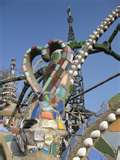Why Wordless Books Work: The Lion and the Mouse
 If we’re trying to help our kids learn to read, why read wordless picture books? Isn’t reading all about letters and words?
If we’re trying to help our kids learn to read, why read wordless picture books? Isn’t reading all about letters and words?
Yes and no.
Reading is: to inspect and apprehend the meaning of writing or other signs or characters. (Thanks, dictionary.com based on the Random House dictionary!) So, reading a book means gaining meaning from the words and from the pictures. Here are some key reading skills kids build when they read wordless books:
- Comprehension as they follow the story shown in the pictures
- Print concepts (we read top to bottom, left to right)
- Sequencing
- Inferring
- Predicting
- Vocabulary
How can a wordless book build a child’s vocabulary? Research led by professors Sandra Gilliam, Ph. D. and Lisa Boyce, Ph. D. from the Emma Eccles Jones College of Education and Human Services at Utah State University showed that mothers used more complex language when sharing a wordless book with their children than they did when they made comments while reading a book with words. (Utah State University Study Shows Parents Are More Engaged With Their Children When Reading Books Without Text June 07, 2011, www.Businesswire.com retrieved June 15, 2012)
And of course, the most important reason to share wordless books is because these books draw kids into a world where even those who struggle with letter recognition can successfully read a fantastic story.
The Lion and the Mouse by Jerry Pinkney is a gorgeous “retelling” one of Aesop’s fables. It won the Caldecott medal, with good reason. Young ones will enjoy the art, and older ones can discuss the deeper layers of the fable.
Before reading The Lion and the Mouse, talk about reading a book with no words. We readers have to really examine the art to understand what is going on. Share this book and let your students either turn to a partner to share or tell the whole group what is happening in the story. Ask students to predict what will happen when they see the hunters setting up the trap and then the lion’s foot stepping on a rope. Use rich vocabulary yourself as you add to the conversation about the plot and what will happen next.
As a writing activity, students can write the dialogue between the lion and the mouse on sticky notes and put them on appropriate pages to read aloud to a friend. It’s perfect for retelling if you make a storybox with a stuffed lion and mouse, and a length of string. No matter what the reading level of your students, all of them will enjoy successfully reading The Lion and the Mouse.
Read MoreToys 100 Years Ago
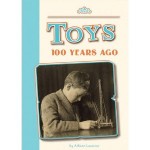 It is only Day 3 of summer vacation, and already I’m hearing the words guaranteed to make a parent go bonkers: “I’m bored!” I point out the oodles of toys, many of them electronic and almost all of them plastic, that litter my house and yet, my child still insists that “there’s nothing to do”. Before I threaten my precious darling with a list of chores that could keep him occupied miserably for the next three months, I gently sit him down beside me to read this book.
It is only Day 3 of summer vacation, and already I’m hearing the words guaranteed to make a parent go bonkers: “I’m bored!” I point out the oodles of toys, many of them electronic and almost all of them plastic, that litter my house and yet, my child still insists that “there’s nothing to do”. Before I threaten my precious darling with a list of chores that could keep him occupied miserably for the next three months, I gently sit him down beside me to read this book.
Toys 100 Years Ago by Allison Lassieur is one of those wonderful nonfiction books that doesn’t read like a dry encyclopedia entry. The sepia photos of children from 100 years ago playing with Tinker Toys and Erector sets make me want to build something. Toys 100 Years Ago is an early reader book, so the words are simple enough for even young ones to understand. I love the section that talks about “homemade fun” and describes how kids used to make their own toys by cutting paper dolls, building model airplanes, and swinging on rope swings.
After reading this book, my child and I can discuss how it truly is possible to have fun without batteries, plastic, or electricity. In a classroom, I’d make a “Then and Now” chart with my students, and I’d share other books from the 100 Years Ago series, on topics like food, clothes, and school. At home or in the classroom, kids can use newspapers and magazines, popsicle sticks and crayons, string and clay to make their own kites, airplanes, dollhouses – anything they can imagine – just like the kids who, 100 years ago, dared to whine to their parents, “I’m bored!”
Read More“The Purple Balloon” for all who miss Kenley
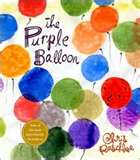 Our community is mourning the loss of Kenley, a bright-eyed, curious toddler who died this weekend in a tragic accident. How do we, as grown-ups who are heartbroken and confused, make sense of any of this for our children or give them comfort as we grieve for this little girl? Many books written for children about death and dying focus on the loss of a pet, or an elderly grandparent. The loss in these books is often made easier to bear by describing the long, happy life that came before death. When a child dies, there is little comfort to be found and no easy answers. Here are two books that you can share with children that offer gentle reassurance no matter what your faith is.
Our community is mourning the loss of Kenley, a bright-eyed, curious toddler who died this weekend in a tragic accident. How do we, as grown-ups who are heartbroken and confused, make sense of any of this for our children or give them comfort as we grieve for this little girl? Many books written for children about death and dying focus on the loss of a pet, or an elderly grandparent. The loss in these books is often made easier to bear by describing the long, happy life that came before death. When a child dies, there is little comfort to be found and no easy answers. Here are two books that you can share with children that offer gentle reassurance no matter what your faith is.
The Purple Balloon by Chris Raschka is a very simple picture book that can be shared even with very young children who are grieving. Raschka writes, “There is only one thing harder to talk about than someone old dying – someone young dying.” What can help, he explains, are family members and friends, doctors and nurses, neighbors and classmates and teachers “all listening or talking, sitting or holding, being noisy or being quiet. Good help makes dying less hard.” Raschka draws people as balloons, because health care professionals have found that terminally ill children, when asked to “draw their feelings”, often draw a purple or blue balloon floating free.
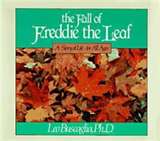 The Fall of Freddie the Leaf: a story of life for all ages by Leo Buscaglia, Ph.D. is a longer picture book. There is a great deal of beautiful language that can be abbreviated for younger listeners. Freddie sees his fellow leaves change colors and fall, and he is afraid. His wise friend Daniel explains that all living things grow and change and eventually die, and that life with all its beauty is a great mystery to be embraced. Finally it is Freddie’s time, “and as he fell, he saw the whole tree for the first time. How strong and firm it was! He was sure that it would live for a long time and he knew that he had been a part of its life and it made him proud.” This book can be a springboard to talk with your children about your personal beliefs and faith.
The Fall of Freddie the Leaf: a story of life for all ages by Leo Buscaglia, Ph.D. is a longer picture book. There is a great deal of beautiful language that can be abbreviated for younger listeners. Freddie sees his fellow leaves change colors and fall, and he is afraid. His wise friend Daniel explains that all living things grow and change and eventually die, and that life with all its beauty is a great mystery to be embraced. Finally it is Freddie’s time, “and as he fell, he saw the whole tree for the first time. How strong and firm it was! He was sure that it would live for a long time and he knew that he had been a part of its life and it made him proud.” This book can be a springboard to talk with your children about your personal beliefs and faith.
Grieving is so difficult, especially for a child, but some solace can be found in the arms of people who love you. Cuddle your little ones close. Share a book. Talk about feelings. Draw or write if it helps. Know that in time the pain will ease.
Read MoreAdventures in Cartooning: how to turn your doodles into comics!
 The Center for Cartoon Studies presents: Adventures in Cartooning (how to turn your doodles into comics!) by James Sturm, Andrew Arnold, and Alexis Frederick-Frost is just what the budding cartoonist needs. A knight, a magical elf, and a candy-loving horse are on a quest to defeat a dragon, but the plot is only a part of this book’s charm. With each step in the adventure, we learn a new technique in cartooning. The little boxes around the pictures are called panels, and changing the background in the panels can make it look like the characters inside the panels are traveling. “In comics,” explains the elf, “words are as important as pictures!” so when the knight wants to let the reader know the castle wall is a thousand miles long, he doesn’t have to draw a reaaallly big panel to contain it all, he describes with his words in a speech bubble. In the end when all seems lost, the characters take fate into their own hands, by drawing and writing a new ending that leads to the next great adventure.
The Center for Cartoon Studies presents: Adventures in Cartooning (how to turn your doodles into comics!) by James Sturm, Andrew Arnold, and Alexis Frederick-Frost is just what the budding cartoonist needs. A knight, a magical elf, and a candy-loving horse are on a quest to defeat a dragon, but the plot is only a part of this book’s charm. With each step in the adventure, we learn a new technique in cartooning. The little boxes around the pictures are called panels, and changing the background in the panels can make it look like the characters inside the panels are traveling. “In comics,” explains the elf, “words are as important as pictures!” so when the knight wants to let the reader know the castle wall is a thousand miles long, he doesn’t have to draw a reaaallly big panel to contain it all, he describes with his words in a speech bubble. In the end when all seems lost, the characters take fate into their own hands, by drawing and writing a new ending that leads to the next great adventure.
Students will love all the techniques they learn in Adventures in Cartooning. You can put those skills to use in a writing activity that shows reading comprehension. Give students a simple story, perhaps a folk tale, or a short story that fits in with some part of your curriculum. After your students read the story, or after you’ve read it to them, let them make a comic strip that will show part of the plot or information they learned. Encourage students to use word balloons and thought balloons (there’s a difference in how they are drawn so readers know if the words are spoken aloud or thought in a character’s head!), panels, lines for movement and action, and backgrounds. Model for students how you might draw a panel to show action. It’s not about perfect drawing, but in finding a way to express your ideas in pictures and in words. In this one lesson, you’ll enhance the Common Core State Standards of Print Concepts, Phonics and Word Recognition, Key Ideas and Details, and Craft and Structure. Even better, your students will be involved in meaningful reading and writing – and enjoying it!
Read MoreGo Graphic with Binky the Space Cat!
 Summertime for kids means no alarm clocks, no spelling tests, no book reports. Summertime shouldn’t mean “no reading” – we just have to find ways to make reading part of the fun. Graphic novels like Binky the Space Cat by Ashley Spires are perfect for summer reading. Some kids (and parents) gasp when I say that graphic novels and comic books “count” as reading. Of course they do! Open up Binky the Space Cat and you’ll find rich vocabulary, an enticing main character, an action-riddled plot, all the components of a good book. But with comics and graphic novels, you also get art that draws in readers, especially reluctant ones. Spires’ illustrations tell as much of the story as her words do, so reading the pictures is as much of a comprehension exercise as is reading the text.
Summertime for kids means no alarm clocks, no spelling tests, no book reports. Summertime shouldn’t mean “no reading” – we just have to find ways to make reading part of the fun. Graphic novels like Binky the Space Cat by Ashley Spires are perfect for summer reading. Some kids (and parents) gasp when I say that graphic novels and comic books “count” as reading. Of course they do! Open up Binky the Space Cat and you’ll find rich vocabulary, an enticing main character, an action-riddled plot, all the components of a good book. But with comics and graphic novels, you also get art that draws in readers, especially reluctant ones. Spires’ illustrations tell as much of the story as her words do, so reading the pictures is as much of a comprehension exercise as is reading the text.
Before you set them free for summer vacation, entice your students by reading aloud the first 17 pages of Binky the Space Cat. This is where we learn that Binky is (or thinks he is) a super-top-secret Space Cat, with a mission “to one day blast off into outer space…” even though he hasn’t ever actually been outside. Inside his Space Station (house), he takes good care of his humans by protecting them from ALIENS!! (flies). There’s an obvious, hilarious disconnect between the words and the pictures, and your students will realize that what Binky thinks is not exactly what’s really going on. Talk with your students about Binky’s misconceptions. What does Binky think about outer space? What might happen if Binky actually went to “outer space”? What do you think Binky would use to build a rocket ship? Tell students that this is something Binky does later in the book, then prepare yourself for lots of hands reaching to read for themselves what happens next.
The publisher of the Binky series put together these free printable Binky activity sheets from Kids Can Press. One sheet encourages students to create a secret identity for their pet and to write about it using captions, word balloons, and sound effects. Another sheet in the Kids Can Press packet shows step-by-step how to draw Binky. Print off these sheets for your students, or if that feels too much like schoolwork, give students blank paper, rulers and art supplies to create their own comic books or cartoon strips. Comics and graphic novels like Binky the Space Cat can make reading and writing fun all summer long.
Read MoreJust a Second: a different way to look at time
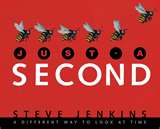 How many times do you think a hummingbird beats its wings in just one second? 10? 20? Steve Jenkins makes math irresistible in Just a Second: a different way to look at time. In one second, a hummingbird beats its wings 50 times. In one minute, a grizzly bear can charge one half-mile. Just a Second is full of information that fits well into units on time, measurement, and estimation, plus it’s visually captivating with Jenkins’ signature cut-paper art. His process in making the collages for his book is really cool, and you can see a video of how his books come together on his website: stevejenkinsbooks.com.
How many times do you think a hummingbird beats its wings in just one second? 10? 20? Steve Jenkins makes math irresistible in Just a Second: a different way to look at time. In one second, a hummingbird beats its wings 50 times. In one minute, a grizzly bear can charge one half-mile. Just a Second is full of information that fits well into units on time, measurement, and estimation, plus it’s visually captivating with Jenkins’ signature cut-paper art. His process in making the collages for his book is really cool, and you can see a video of how his books come together on his website: stevejenkinsbooks.com.
Before reading Just a Second, make some predictions with your students, like how many breaths do you think an adult takes in one hour? (900!) After reading the book and checking your predictions, make and test some new predictions about time. How many jumping jacks can you do in one minute? How long will it take you to flap your arms 50 times like a hummingbird? Can you sit perfectly still and quiet for a full minute? You can compare students’ results on charts or a graph. You can even make a pictograph of your classroom results, and let students make cool representations for themselves with cut-paper art. It may take a bit longer than “just a second”, but it will be time well spent.
Read MoreDream Something Big
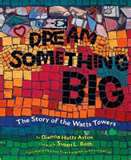 Dream Something Big: the Story of the Watts Towers, written by Dianna Hutts Aston with collages by Susan L. Roth, is a visually stunning biography of an artist you may never have heard of before. Simon Rodia was simply Uncle Sam to his neighbors in Los Angeles. Over 34 years, Sam built towers from broken bits of tile, glass, and cement that soar up to 99 feet high. His incredible recycled-art structures are now a National Landmark.
Dream Something Big: the Story of the Watts Towers, written by Dianna Hutts Aston with collages by Susan L. Roth, is a visually stunning biography of an artist you may never have heard of before. Simon Rodia was simply Uncle Sam to his neighbors in Los Angeles. Over 34 years, Sam built towers from broken bits of tile, glass, and cement that soar up to 99 feet high. His incredible recycled-art structures are now a National Landmark.
At the end of this gorgeously illustrated book you’ll find jaw-dropping photos of the Watts Towers. I’m including a close-up of the towers here so you can see the details as well as a photo that shows just how huge these works of art are. Share Dream Something Big with your students and do a fun math activity. Just how tall is a 99-foot tower? Get out the rulers and chalk and head to the playground or parking lot. Divide 99 by the number of students you have and let them take turns measuring and marking out each foot in 99 feet. Stand at one end of the length when you are done and imagine that distance soaring into the sky. Decorate the 99 feet with chalk “collages”, coloring bright shapes to resemble Sam’s art. Build your own towers with scrap materials, pipe cleaners, clay, etc. and encourage your students to “dream something big” like Sam did. For more inspiration, visit Dianna Hutts Aston’s website: diannahaston.com or Susan Roth’s website: susanlroth.com
Read More



